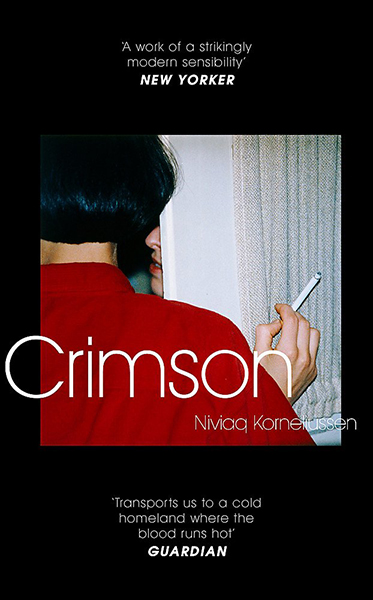

Note: The US edition is titled “Last Night in Nuuk”
The first Greenlandic novel was published in 1914, exactly a century before Crimson. Most of the Greenlandic literary tradition is characterised by stories about nature, hunting and family which made Crimson, an urban story about young queer people somewhat of a revelation that garnered a lot of national attention, but was also nominated for several Scandinavian literary awards and has been widely translated.
The book contains several Greenlandic word plays that give you a glimpse of how satisfying the story must be to read in the original but there is a glossary that helps the reader of the English translation understand the gist of it.
Crimson consists of five chapters, each giving us a point of view narrative from one of the five LGBT characters (there is at least one character for each of the acronym letters, including a bisexual woman). Their stories are interconnected, often giving you different characters’ perspectives on the same events, granting empathy and grace to all of them, even if they might be a villain in someone else’s eyes.
Year of publication:
2014
Country of publication:
Greenland
Page count:
192
English translation:
Yes
Would I recommend this book?
Yeah
The format of the book is mixed, consisting of first person narrative, letters, text messages (formatted to look like screenshots), even photos and hashtags. Most of them work, but some which might have seemed interesting and fresh in 2014, now just read like a cheesy and disruptive gimmick (hashtags, pop music references). The last chapter, the one with the hashtags, is overall the weakest, both story wise (that character has the least of an independent story) and style wise, with the melodramatic self pity reading more like a 2014 Tumblr post than a clever literary reworking thereof.
The rest of the characters are also very dramatic and troubled, but their stories work a lot better. The book’s strongest suit is capturing the chaotic, self destructive experience of being a queer person in their early 20s. There is a lot of drinking and partying as a coping mechanism, a lot of cheating and relationship drama, friendship ups and downs and several gender/sexuality revelations.
The gay and lesbian chapters seem to understand their characters a bit more intimately than the bisexual one - I could tell even before I looked it up that the author was a lesbian. Trans readers seem to have mixed thoughts about the trans chapter.
The bisexual chapter is the only one that doesn’t end on an optimistic note - it’s implied that the bi character is about to repeat her (self) distructive cycle. Contrasting her ending to the others does have some unfortunate implications but at the same time that ending also makes it stronger from a literary perspective - not everyone can resolve their problems in the short time in which the book’s events unfold and without this chapter, the whole novel might seem too saccharine.
All in all, Crimson is a gripping, fast read whose clever structure makes up for some of the stylistic weaknesses. Critics have called it “clumsy” and “unabashedly sentimental” but also admitted it was raw and touching. It lets its queer characters be messy and captures the atmosphere of a small town, where you can never be truly anonymous. A unique, memorable debut.
